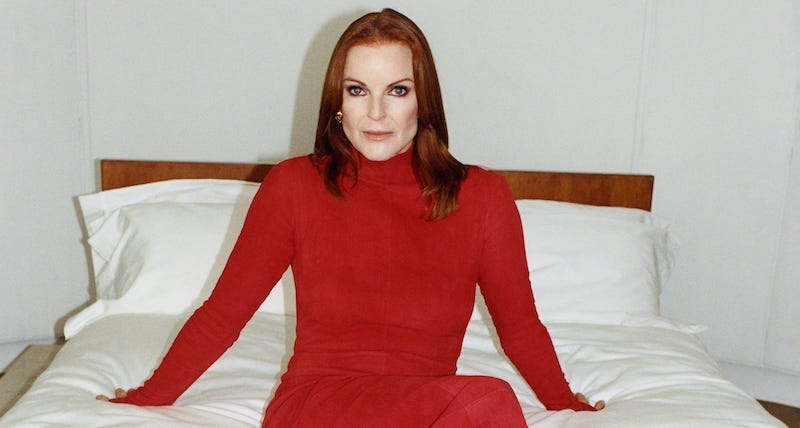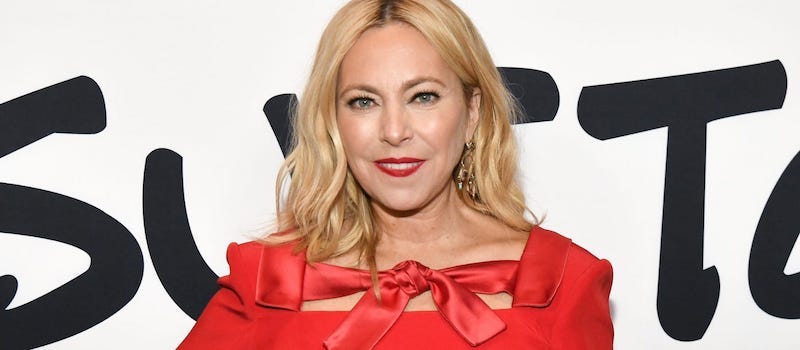My Favorite White Women
Lessons I've learned from women who would be jealous of my ugly leather pants.
It's been established that if you didn't grow up white, then as a minority, you probably didn't see yourself represented in the media. Celebrities forever whine about it to appear topical and relevant. And like, sure, I guess.
But that wasn't my reality because I felt represented on screen by the most popular minority there is—the white woman. These white women spurred in me who I am, who I could be, and who I want to become.
Marcia Cross
Marcia Cross cemented herself in pop culture history as “That Bitch” with her portrayal of Dr. Kimberly Shaw on Melrose Place. And on April 27, 1994, Marcia cemented herself in my life when she moved rent-free into my head with her legendary wig reveal that stopped the world.
Melrose Place was a staple in my house growing up. With my twenty-something single mother, we would huddle around the T.V. every Monday to watch the wonderfully wicked residents of 4616 Melrose Place lie, cheat, and cause scandal. I was only a toddler when it first aired. However, I still remember the thrill and danger of witnessing the drama—and the scolding my father gave me when he found out his four-year-old was a connoisseur of nighttime soaps.
Dr. Kimberly Shaw ripping off her human-hair unit to reveal a gnarly Frankenstein-esque head scar underneath was one of the first images I can remember being burned into my brain. It’s safe to say it was also the first time I was officially gagged.
Marcia Cross is the moment that made me say, “Culture is for me.” She is an icon, my favorite Desperate Housewife, and an anal cancer survivor and activist—and anyone vulnerable enough to talk about their butthole on Good Morning America is a slay.
Mindy Kaling
I’ve been told I navigate the world with white girl entitlement but without white girl privilege. And if I do, it’s because of Mindy Kaling. Mindy gets thrown under the fire for blatantly aligning herself with whiteness. But, in one way or another, whether you know it or not, we’re all doing the same thing.
Like The One Ring was forged by the Dark Lord Sauron in Mount Doom, whiteness was forged by white supremacy in America. Like the One Ring is coveted for its power, so is whiteness. Many of us grow up chubby and denounce sports, and so we spend our formative years glued to T.V. sets that convince us to aspire to such. We all aspire to whiteness—the institution of whiteness makes it so.
Mindy aspired and achieved, building a T.V. empire and producing shows where brown girls fall in love with white twinks and Chris Messina. She knows what she wants, and she gets it. Let the boogers have the activism—she’ll take the Ozempic. Mindy and I both know what we want, and we know we deserve it—and what’s wrong with that?
Although, one must remember the warning of Icarus and beware of flying too close to the sun. Because, on the one hand, you could end up with a T.V. empire like Mindy or get duped into a $1,200 yoga teacher training in Orange County like me.
Selina Kyle After the Cats Get Her (Tim Burton’s Version)
Selina Kyle After the Cats Get Her (Tim Burton’s Version) is an example of being a byproduct of a world that forgets you and betrays you. In Batman Returns, we meet her as a mousey executive assistant—invisible and given no value. But when her greedy, murderous boss pushes her out of a window, her mousiness falls prey to her inner feline instincts—neuroticism, extraversion, dominance, and impulsiveness.
Selina was my first example of a glow-up. Her evolution into Catwoman showed me that I, too, could survive adversity by owning my confidence and working my pussy out. She was also my first exposure to queer culture: the campiness of her entire being, her refusal to submit to gender norms, her overt sexual expression—and the liberation she finds in that sexuality.
My favorite scene in Batman Returns is when Selina returns to her dingy pink-walled Gotham City apartment after almost falling to her death and, in her madness, destroys everything in her path. It's the tease before she becomes Catwoman—the shedding of her old identity. In the scene, her warpath leads her to the closet, where she finds the patent leather coat that will soon transform her into her new identity. In a sense, we see her come out of the closet (Hi, gay!). Selina finds her new skin, and two minutes later, we see her wearing it and finally coming into her own.
Because Catwoman stands up for herself, gives in to her desires, and likes to get even, she is often painted as a villain. But she is a rulebreaker, not a villain. Selina Kyle After the Cats Get Her (Tim Burton’s Version) is a reminder that some rules are meant to be broken, and she is my role model for breaking them.
Tori Spelling
Like a cockroach, Tori Spelling seems to survive it all. Hollywood is her nuclear war, and she’s infamous for a tenacity that boasts her to be the most likely to survive. Despite her highly privileged, richer-than-rich upbringing, Tori has been a fighter in this industry since childhood. Fighting for the love of her withholding Tony Award-winning mother, a spot on her legendary father’s T.V. show by auditioning under the pseudonym “Tori Micthell,” and above all, fighting for relevance.
The troubles of a wealthy white woman are hardly worth our time and sympathy. Still, I’ve always had a strange affinity towards Tori Spelling. No one takes her seriously, thinks she’s pretty, or considers her talented—and I relate. Yet she’s relentlessly pushing to prove herself and make all the naysayers suck it. They often don’t end up sucking it, but my girl still tries.
One of my toxic traits is that I am a pawn in her first line of defense. I will always be that person to make an entire room go, “Huh?” when I unpromptedly tell everyone that “Tori Spelling has great comedic timing.” R.I.P. So NoTORIous.
She has more doubters than fans and is constantly the butt of every joke. But she's survived it all by becoming a satire of herself. It's an admirable power move tinged with sadness, so even though we know she'll survive her irrelevancy, I can't help but feel that she needs me.
Sutton Stracke
Since 2006, The Real Housewives Franchise has had its foot on the neck of gays, stay-at-home moms, and wine-o-clock mamas. I was never one of its devotees until Miss Deep South Sutton Strake lured me into the world of The Real Housewives of Beverly Hills.
Freshman Housewife and coconut water connoisseur Crystal Kung Minkoff ignited the drama that would be my key to the Real Housewives kingdom when she confronts Sutton with racist accusations, "Tell me you're that girl. 'I don't see color.'" Sutton's white fragility goes into overdrive, and she defends herself with, "I really don't see color. I don't see race."
Tip for those who never finished your 2020 anti-racist reading: the correct answer is that you always see color; you always see race.
The drama between them persists throughout the season into more one-sided discussions on race and Sutton's defining moment, the iconic "Jealous of what? Your ugly leather pants?!" Sutton represented everything I hated about whiteness. Watching her made me boil with AZN rage, frustrated at how someone could be so out of touch, which makes her ascent to the rank of Favorite White Woman so impressive.
Eventually, you learn that Sutton is just a weirdo with no black friends—a Karen who needed a POC to smack some sense into her. And they did, and it worked! She's blossomed from a Southern racist to a Black woman's best white friend. Sutton is an example of growth that all Karens should aspire to.
Currently, Sutton is in her LGBTQ Ally era and makes me laugh more than any other Housewife. She also shows me that even the worst people are redeemable. And to that, I say, "Werk."
Honorable Mentions
Shannen Doherty, Jenna Maroney, Katie Porter, Ashlee Simpson (Autobiography Era).















